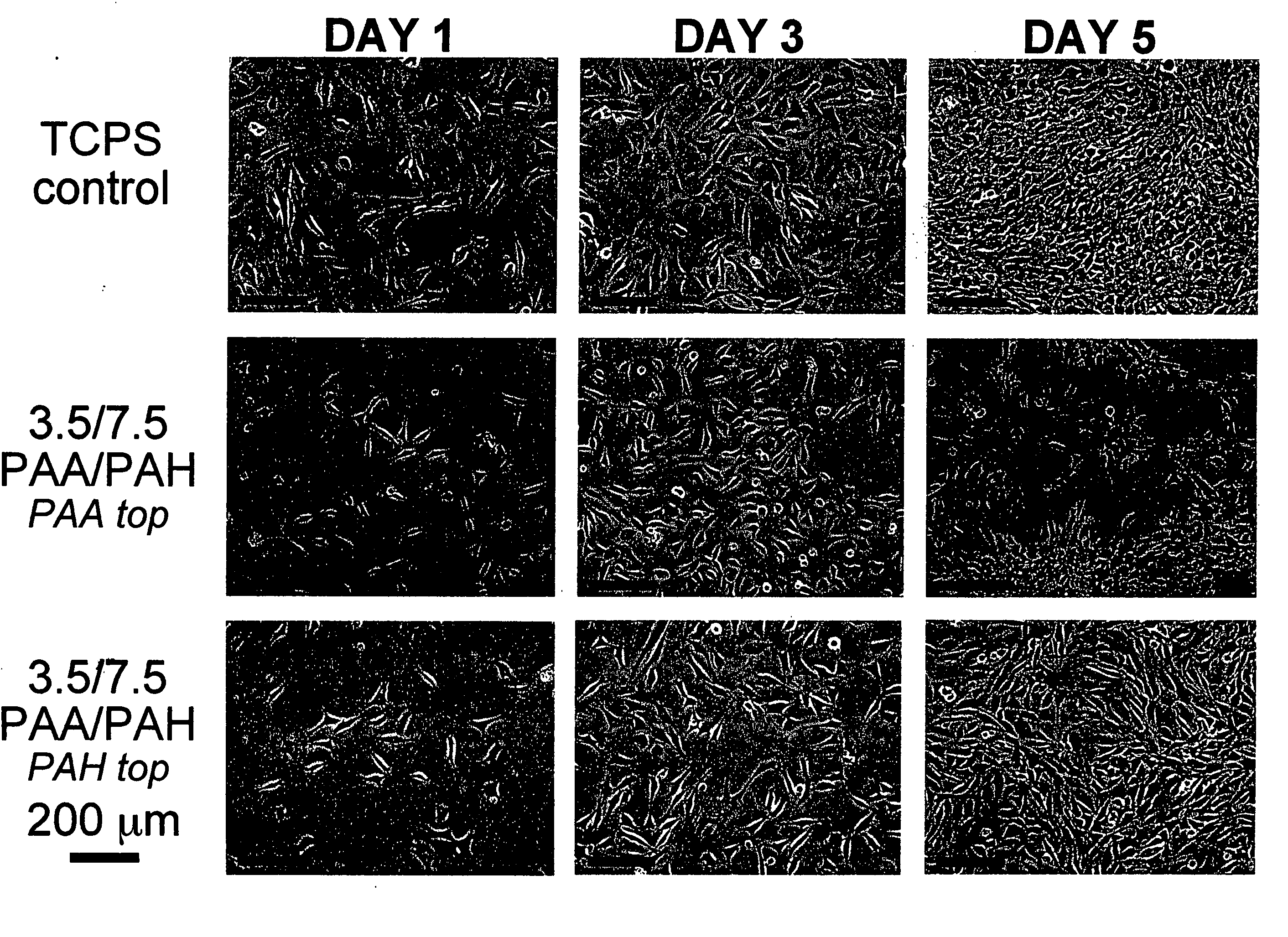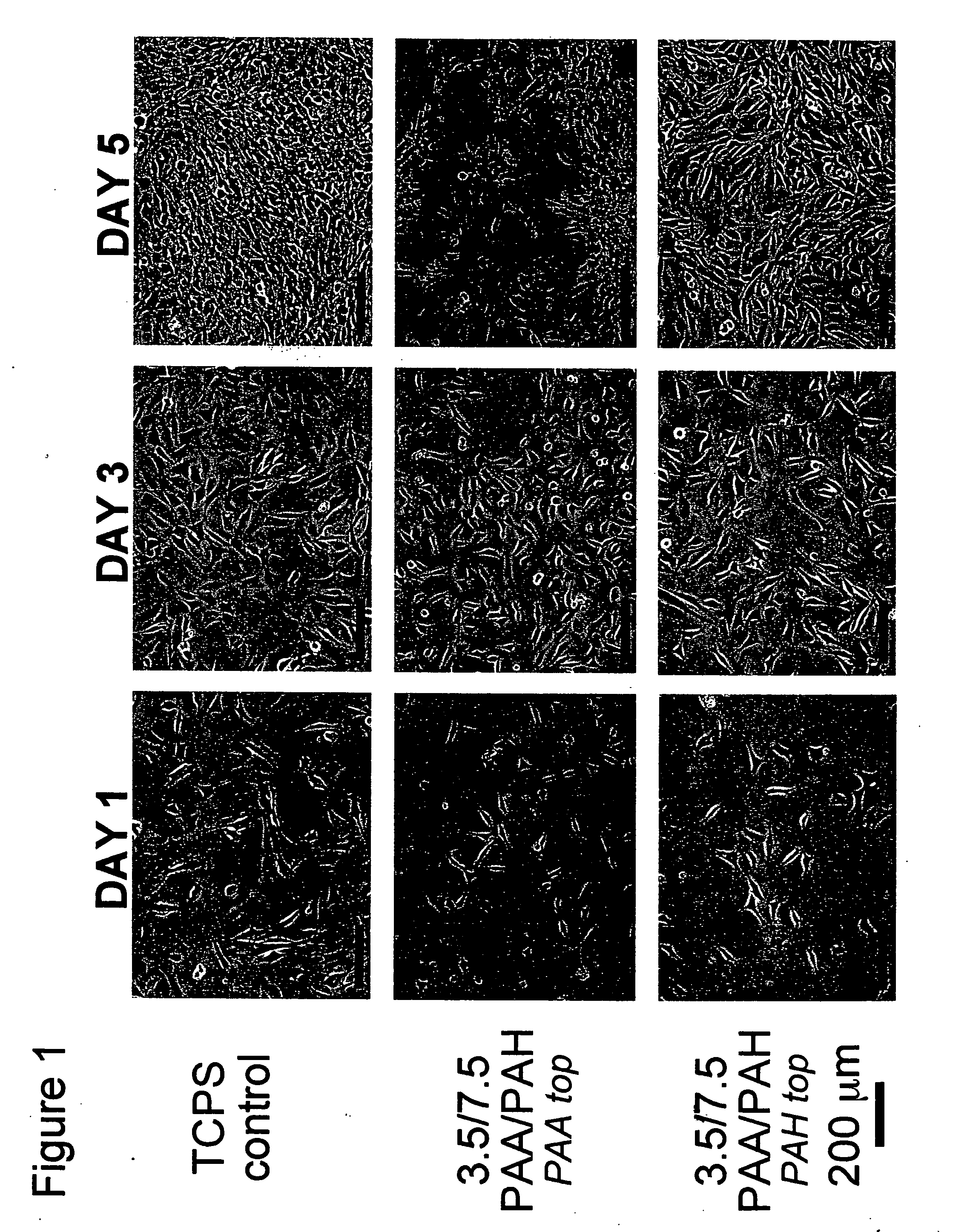Polyelectrolyte multilayers that influence cell growth methods of applying them, and articles coated with them
a polyelectrolyte and multilayer technology, applied in the field of polyelectrolyte multilayers that influence cell growth, can solve the problems of poor device performance, increased risk of infection, and detrimental clinical complications, and achieve the effect of preventing cell adhesion and preventing cell adhesion
- Summary
- Abstract
- Description
- Claims
- Application Information
AI Technical Summary
Benefits of technology
Problems solved by technology
Method used
Image
Examples
example 1
Materials
[0105] Poly(acrylic acid) (PAA) (MW˜90,000, 25% aqueous solution), poly(methacrylic acid) (PMA) (MW˜100,000), and polyacrylamide (PAAm) (MW˜800,000, 10% aqueous solution or 5,000,000, 1% aqueous solution) were obtained from Polysciences. Poly(allylamine hydrochloride) (PAH) (MW˜70,000), sulfonated poly(styrene), sodium salt, (SPS), (MW˜70,000), poly(diallyldimethylammonium chloride) (PDAC) (MW˜100,000-200,000) as a 20 wt. % solution, the methylene blue dye, and the rose bengal dye were purchased from Aldrich Chemical. The polymers were used without any further purification. Lysozyme (from chicken egg white, E.C. 3.2.1.17) and fibrinogen (fraction I, type I-S from bovine plasma, E.C. 232-598-6) were obtained from Sigma and prepared as 1 g / L and 0.2 g / L solutions, respectively, in Dulbecco's phosphate buffered saline (PBS) (pH˜7.4, with calcium and magnesium).
[0106] All polymer solutions were prepared as 10−2 M solutions (based on the repeat unit molecular weight) using de...
example 2
Preparation of Polyelectrolyte Multilayer Thin Films
[0109] All polyelectrolyte multilayer thin films were deposited directly onto tissue culture polystyrene (TCPS) petri dishes and multiwell plates (Falcon), TCPS slides (Nalgene), polished silicon wafers (Wafemet), glass slides (VWR Scientific), and ZnSe crystals (SpectraTech) at room temperature via an automatic dipping procedure using an HMS programmable slide stainer from Zeiss, Inc. The TCPS substrates were first immersed in the polycationic solution (e.g., PAH) for 15 minutes followed by rinsing in 3 successive baths of deionized neutral water (pH≈5.5-6.5) with light agitation, for 2, 1, and 1 minute(s), respectively. The substrates were then immersed into the oppositely charged polyanionic solution (e.g., PAA, PMA, or SPS) for 15 minutes and subjected to the same rinsing procedure. This process was repeated until the desired number of layers was assembled, after which the coated substrates were removed from the automatic di...
example 3
Film Thickness
[0111] The thickness and refractive index of the multilayer films deposited onto silicon were measured using a Gaertner ellipsometer, operating at 633 nm.
Film Roughness and Morphology
[0112] Atomic force microscopy (AFM, Digital Instruments Dimension 3000 Scanning Probe Microscope, Santa Barbara, Calif.) was used in tapping mode with Si cantilevers for surface morphology profiling and roughness measurements (dry state) of sample films built on silicon. Typically, square images of 1×1, 5×5, or 10×10 μm2 images were obtained for samples using a scanning rate of ˜1-1.5 Hz, a setpoint ˜1-1.5 V, and a resolution of 512 samples / line.
UV-visible Spectroscopy
[0113] Samples assembled onto glass substrates were immersed in either the methylene blue solution (prepared as a 10−3 M solution in Millipore water, adjusted to pH˜7.0) or the rose bengal dye solution (10−3 M solution in Millipore water, adjusted to pH˜5.0) for 15 min followed by 3 successive deionized neutral water...
PUM
| Property | Measurement | Unit |
|---|---|---|
| Temperature | aaaaa | aaaaa |
| Fraction | aaaaa | aaaaa |
| Fraction | aaaaa | aaaaa |
Abstract
Description
Claims
Application Information
 Login to View More
Login to View More - R&D
- Intellectual Property
- Life Sciences
- Materials
- Tech Scout
- Unparalleled Data Quality
- Higher Quality Content
- 60% Fewer Hallucinations
Browse by: Latest US Patents, China's latest patents, Technical Efficacy Thesaurus, Application Domain, Technology Topic, Popular Technical Reports.
© 2025 PatSnap. All rights reserved.Legal|Privacy policy|Modern Slavery Act Transparency Statement|Sitemap|About US| Contact US: help@patsnap.com



